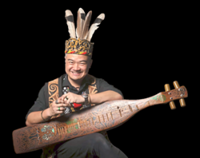A record 257 sape musicians performed at the Citrawarna Keluarga Malaysia finale at the Kuching Waterfront in Sarawak.
IN FEBRUARY this year, 257 sape musicians gathered at the Kuching Waterfront to play a concert for the Citrawarna Keluarga Malaysia finale, a four-day programme that showcased cultural performances and traditional activities.
The show made it into the Malaysia Book of Records for having the most number of sape players in a single performance.





